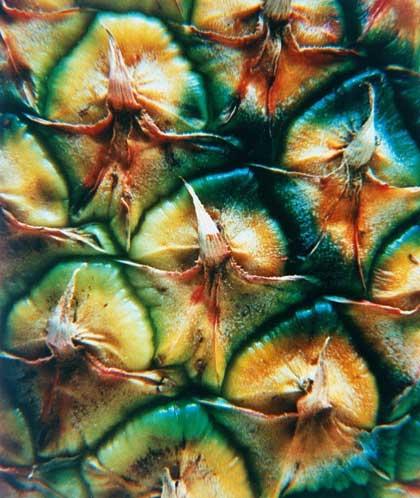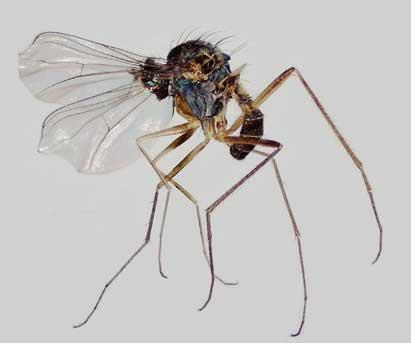Symmetry is not always a law
2004/11/01 Roa Zubia, Guillermo - Elhuyar Zientzia Iturria: Elhuyar aldizkaria

What does the beauty of nature consist of? In colors? In the forms? In diversity? Surely it is all this, that and a thousand more things. And within this set of features also has room symmetry. Symmetry brings order; symmetrical images convey balance to us, with which we often associate beauty. Symmetry is beautiful even when it is broken by some element.
It is beautiful, but not only beautiful; besides beauty, there are other reasons to study the symmetry of nature, which is sometimes the explanation of many secrets about nature itself. Examples can be found everywhere.
For example, pineapple has a very complex symmetrical structure that manifests itself in the design of the skin. Ana's skin seems beautiful, but for botanists it is not a simple beauty. This structure indicates that the development of the pineapple itself is due to "norms".

Ana's symmetry is just an example, there are many more. But symmetry is not always law. Sometimes, symmetric designs are the most efficient, in others not. Sometimes symmetry is the logical expression of nature, sometimes not. However, nature is as it is, since in many cases symmetry breaks or disappears. And it is worth analyzing at least in three areas.
From left to right
They say that the British Charles Darwin questioned that God had designed all living things, one by one. Not all the details that change from one to the other were the fruit of the work of the Father of Heaven. On the contrary, the old idea of evolution seemed much more adequate: all species should come from the changes of the previous ones.
The traces of the evolutionary steps are still evident today, for example, in animal symmetry. Of course, creating new animal designs over time does not make the old ones disappear.
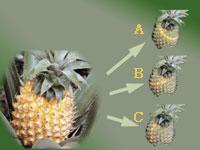
Symmetric development of Ana
Therefore, there are still animals with the body ordered around an axis, that is, radial symmetry, like the jellyfish. In the past, the most complex animals had that appearance, because it was the most logical organization of those who had more than one cell, simple and effective.
But with time more complex animals appeared and from a moment the radial bodies were not sufficiently effective for them. This caused changes in the bodies. For example, animals developed the head to join the central nervous system and the main organs of the senses in a part of the body. And being a complex head demanded a new organization of the body, on two sides, on the left and on the right.
This symmetry was very successful. For example, worms and worms, despite their cylindrical appearance, have a bilateral symmetry; molluscs, insects and more complex animals. And it is that in today's more complex animals he commands bilateral symmetry, for example in man; the parts of the left body are repeated to the right as if they were an image of a mirror.
Is it true? Are we formed by two equal parts? Seen from outside, perhaps yes. But if we analyze the location of the organs, no symmetry is seen. The heart is on the left, the liver on the right; moreover, the two lungs are not the same: the right is divided into three lobes and the left is only in two. And in some animals, these differences are also reflected in the external appearance, such as the turbot. This seabed fish has lost the symmetry of their ancestors. Why has this happened?
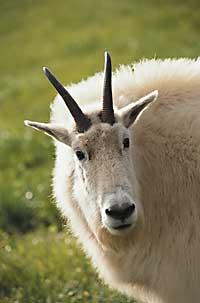
Well simply because it is the only way to maintain an even more complex body. If the human heart were symmetric, it would have serious problems to compensate for blood flow, due to its complexity. And the turbot needs an asymmetric arrangement for its large flat body, which should be adjusted to a flat body. Therefore, bilateral symmetry is not another type of symmetry, but the same asymmetry.
Arrangement of atoms
They say that the Frenchman Louis Pasteur manually distributed the crystals of an acid based on their appearance, and that in the end they had crystals of two acids instead of one. From one got two? This legend does not seem logical, but it has a simple explanation: the initial mixture contained two acids and not one, but the chemicals of the time did not know them.
Pasteur discovered something more important than an acid: the asymmetry of biomoleculae. Life is based on asymmetric molecules. This does not mean that everyone is asymmetric. Water, oxygen, or an amino acid called glycine, for example, are totally symmetrical and essential for life. But many others are asymmetric and for them biological activity consists of having an adequate geometric shape. It is not a smallness, in this group are all the amino acids that are not DNA or glycine, among others. They require a specific geometric orientation and their absence can cause serious problems.
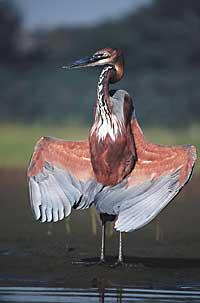
The problem of orientation was solved by nature long ago: all the amino acids involved in the current life, for example, have the same orientation. Each amino acid has, geometrically, two possibilities, being L- or D-amino acid. But almost all the amino acids of nature are L-amino acids. No one knows why, but yes. Another so happens with sugars, which are all of nature.
There are exceptions. Some bacteria use D-amino acids to form their membrane, but one of the reasons is that all the amino acids of nature are L. In short, as for biomolecules, asymmetry affects more biological activity than symmetry.
And accepting this idea, asymmetry raises a series of basic questions about the origin of life: Why did nature choose this option and not the other? Is there another opportunity somewhere alive? On another planet? In another universe? It must be taken into account that the universe is also asymmetric.
Apple Apple Apple Apple Apple Apple Apple Apple Apple Apple Apple Apple Apple Apple Apple Apple Apple Apple Apple
They say that the British Isaac Newton discovered gravity when he saw an apple fall. It probably wasn't, but that indicates that the discovery was a consequence of observation. Things are attracted only by being mass. And that's not easy, but since Newton explained it seems like it does.
However, for physicists, gravity is very special. In short, a mass attracts everyone else without exception. But this does not happen, for example, in electricity or magnetism.

For one particle to electrically attract another, they must have an opposite charge. The positive attracts the negative and another positive repels it, that is, creates a symmetrical zone. It is symmetric only by positive and negative charges. In gravity, on the other hand, all the masses are positive and, however, they are attracted. It is clear that the gravitational force is not like electric or magnetic.
There are no negative masses. It does not exist. However, physicists speak of antimatería. But anti-mating and negative mass are not the same. The antimatería is called to several particles because when they collide with the matter they both get rid. The positron, for example, is an antimatería, similar to the electron, since it has the same mass, but opposite electric charge. If an electron and a proton collide, both become energy; in short, the masses are destroyed.
The positron electron is not the only pair of material anti-mating. Each particle that composes the matter has an antiparticle, for example, the proton and neutron antipartas are, respectively, antiproton and antineutroya. And they all have great importance in the creation of the universe.
According to one hypothesis, during the explosion of Big Bang two were formed: matter and antimatería. But after the explosion they collided with each other. But the matter did not completely disappear. There was "too much" matter. All the antimatería disappeared, but the matter persisted. Not everything disappeared. Why? No one knows it.
However, the matter remained, which allowed the formation of galaxies, stars and planets. Thanks to this the Earth exists and we are. We live thanks to the asymmetry of this shock.
Fish without symmetry

The turbot lives in the bottom of the sea, is a mimetic animal. It hides in the sand waiting for its prey, for what the turbot has a very appropriate aspect for its flat body. Other fish have the flat body, but the turbot is special, especially because this flat body has no symmetry. On the one hand, in this fish the top is not the same as the bottom. On the other hand, although the column is divided into two upper parts, both parts are also not equal. Finally, the mouth, the dorsal fin and the eyes are not at all symmetrical.

Gai honi buruzko eduki gehiago
Elhuyarrek garatutako teknologia




